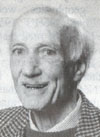
in recognition of his outstanding contributions to magnetospheric and space plasma physics theory
Over the past forty years, many European scientists have made significant contributions to the development of space plasma physics. However, the achievements of one man, James W. Dungey, must surely rank above all others. Dungey’s accomplishments are monumental. Many of the major concepts and theories in space plasma physics and, in particular, in magnetospheric physics, owe their creation to Dungey. He has unselfishly helped to train many of the present leaders in the field. We also should thank Dungey for first proposing the need for a multispacecraft mission to help unravel the complex three-dimensional secrets of the magnetosphere - this idea, of course, now forms the first cornerstone mission (CLUSTER) of ESA’s Horizon 2000 programme. Dungey’s achievements are all the more remarkable in view of his modest and unassuming manner - a characteristic which has resulted in his not always gaining the recognition he rightly deserves.
Dungey’s contributions to the theory of magnetospheric physics come from an exceptional physical insight merging on genius. His ideas, which are always original, are often tangential to current thinking in the field at the time they are proposed. It is remarkable then that his ideas invariably prove correct, in some cases only after several years of experimental endeavour. This consistency of success implies that far more than good luck is involved, for many scientists have proposed novel and stimulating ideas in the field only for them later to be proved incorrect. Rather, Dungey’s record of success is clearly the result of the deepest physical understanding of the workings of nature.
Of the many significant ideas Dungey has instigated, his most profound contribution came in 1961 when he laid the foundations for our present understanding of how the Earth’s magnetosphere is electromagnetically coupled to the solar wind. In this paper, he applied his earlier seminal idea of magnetic reconnection (Dungey, 1953) to introduce the concept of the magnetically "open" model of the magnetosphere. Even today this paper continues to be referenced regularly and it must surely rank as the most cited paper in magnetospheric physics. Its concepts are crucial for understanding all macroscopic features of the magnetosphere, for example, the circulation pattern of plasma within the magnetosphere and the associated structure and dynamics of different plasma populations.
Dungey has played a leading role in the subsequent development of his 1961 paper. In this context one notes his short, but elegantly simple, argument predicting the length of the geomagnetic tail (1965). Slightly later, in a 1967 paper, he explained the formation of the plasmapause simultaneously with, and independently of, Nishida. Dungey also predicted the existence of the plasma mantle, this latter almost a decade before its experimental detection. It was a student of Dungey’s, D.H. Fairfield who (in collaboration with L.J. Cehill, Jr.), produced the first firm experimental evidence for the reconnection model of the magnetosphere, from an association between geomagnetic activity and the direction of the magnetosheath magnetic field (1966).
Another new field of study pioneered by Dungey is that of plasma waves and wave-particle interactions in the magnetospheric context. He initiated the concept (1954) that long-period geomagnetic pulsations result from Alfvén waves standing on geomagnetic field lines and he instigated the important field of study, now referred to as magnetosphere-ionosphere coupling, by considering the interaction between hydromagnetic waves and the ionosphere (1963a). In 1955, he pioneered the suggestion that the Kelvin-Helmholtz (wind-over-water) instability might occur at the magnetopause boundary separating solar wind and magnetosphere plasmas. He was also the first to recognize (1963b) that gyroresonant interactions between whistler-mode waves and Van Allen radiation belt electrons could be significant for precipitating the latter into the ionosphere.
A further characteristic of Dungey’s is his warm generosity to his students, often not co-authoring their papers despite making major contributions. A good example of this unselfish attitude is the paper by Knight (1973) which is now regarded as a standard work in the field. This paper was the first to derive a relation expressing the existence of field-aligned voltage drops in the region connecting flowing magnetospheric and ionospheric plasmas. However, it is little known that this paper originated as an M.Sc. project given by Dungey to a first year postgraduate student which, although excellently completed by the student, actually owed its entire impetus to Dungey.
The list of Dungey’s achievements could go on to include, for example, the theory of the geomagnetic tail in the reconnection model, particle diffusion in the radiation belts, and waves in neutral current sheets, to name three further areas where important contributions have been made. However, by now it should be clear that Dungey’s accomplishments in magnetospheric physics are outstanding and certainly exceed those of any other living worker. Without question he is an exceptional candidate for Honorary Membership of the EGS.
Newsletter 51, 25, 1994